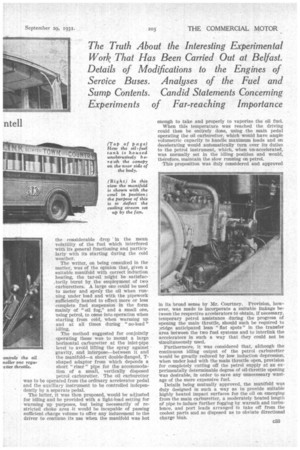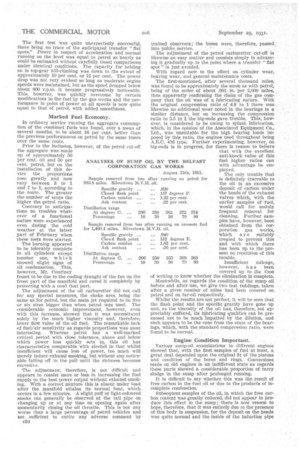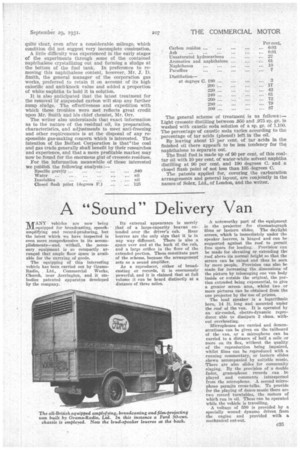CARBURETTING GAS-TAR OILS
Page 54

Page 55

Page 56

Page 57

If you've noticed an error in this article please click here to report it so we can fix it.
The Truth About the Interesting Experimental Work That Has Been Carried Out at Belfast. Details of Modifications to the Engines of Service Buses. Analyses of the Fuel and Sump Contents. Candid Statements Concerning Experiments of Far-reaching Importance
AGOOD deal of attention has recently been attracted to the experiments on the carburation of gas-tar oils at present being carried out by the Belfast Omnibus Co., Ltd. Details of these have already been published in the daily Press, mostly with regrettable inaccuracies, extending in many cases to a complete misrepresentation of the actual nature of the work in progress.
The writer is directly responsible for the broad lines of the bi-fuel scheme employed which has been Most promisingly developed with the able co-operation of Mr. James Courtney, the chief engineer of the above company, and successfully put into passenger service in Ulster by him. At the time of writing 10 of tbese buses are operating over their ordinary routes, without any unusual manifestations 'whatever that could suggest the original nature of the carburant, even to passengers having a professional knowledge of internal-combustion engineering.
With the permission of the Belfast Omnibus Co., Ltd., and of Solex, Ltd., London, the carburetters of which are successfully used throughout, the writer is able to detail the main principles of the scheme.
Thts: carburation of cheap, high-boiling-point residual oils has long been the subject of experiments, but although in many cases these have been technically successful the expense and mechanical complication involved in their carrying out and their dependence upon the human element, in the form of unskilled drivers, has either severally or collectively prevented, up to now, their general use commercially in Great Britain ; this has obtained despite the attraction of greatly reduced fuel cost, which forms so important an item in the balance sheets of public services or heavytraction companies.
c32 From long observation it has been the considered opinion of the writer that these failures were, in a great measure, the result of attempting to make the oil function not only as a power fuel but also as one for idling purposes. It seemed also evident that the consequent plug troubles, gumming-up of valves and undue sump dilution, did not result from any very imperfect combustion when under moderate and full load, for under these conditions the vaporizing arrangements were probably hot enough and the induction velocity and charge turbulence high enough to assure of moderately complete burning_ It seemed much more probable that they took place under idling and smallthrottle-opening conditions generally, ture of the would drop during which the tempera evaporating arrangements to an inadequate heat. This, with the accomPanying low velocities, seemed bound to induce considerable fuel deposition and incomplete combustion from
which sump dilution would obviously The main aceele, follow. carburetter, whilst Prior to the writer's association with lates the Petrol.
it, :the Belfast Omnibus Co., Ltd., had for some time been experimenting with oil-petrol mixtures, used in the standard carburetters and induction layout. It employed for that purpose a tar-oil supplied by the Belfast Corporation gas works, which was stated to have some uSeful characteristics in respect of high anti-knock qualities, unusually good calorific value, and to be free from any corrosive agents that could injure the bearings in case of undue sump dilution. Its use, however, as a simple diluent for straight carburation did not prove successftil, owing to the considerable drop ' in the mean volatility of the fuel which interfered with its general functioning and particularly with its starting during the cold weather.
The writer, on being consulted in the matter, was of the opinion that, given a suitable manifold with correct induction heating, the tar-oil might be satisfactorily burnt by the employment of two carburetters. A large one could be used to meter and sprawy the oil when running under load and with the pipework sufficiently heated to effect more or less complete fuel suspension -in the form mainly of "oil fog," and a small one, using petrol, to come into operation when starting from cold, when warming up and at all times during " no-load " idling.
The method suggested for conjointly operating these was to mount a large horizontal carburetter at the inlet-pipe level to avoid lifting the spray against gravity, and interpose—between it and the manifold—a short double-flanged, Tshaped adaptor from which depends a short " riser " pipe for the accommodation of a small, vertically disposed petrol carburetter. The oil carburetter was to be operated from the ordinary accelerator pedal and the anxiliary instrument to be controlled independently by a separate pedal.
The latter, it was then proposed, would be adjusted for idling and be provided with a light-load setting for warming up purposes, 'but being necessarily of restricted choke area it would be incapable of passing sufficient charge volume to offer any inducement to the driver to continue its use when the manifold was hot enough to take and properly to vaporize the oil fuel.
When this temperature was reached the driving could then be entirely done, using the main pedal operating the oil carburetter, which would have ample volumetric capacity to handle maximum loads and on decelerating would automatically turn over its duties to the petrol instrument, which, when un-accelerated, was normally set in the idling position and would, therefore, maintain the slow running on petrol.
This proposition was duly considered and approved in its broad sense by Mr. Courtney. Provision, however, was made to incorporate a suitable linkage between the respective accelerators to obtain, if necessary, temporary petrol assistance during the progress of opening the main throttle, should such be required to )ridge anticipated lean 'fiat spots" in the transfer area between the two fuel systems and to haterlink the accelerators in such a way that they could not be simultaneously used.
Furthermore, it was considered that, although the continuous idling output of the petrol carburetter would be greatly reduced by low induction depression, when under load with the main throttle open, provision for completely cutting off the petrol supply at an experimentally determinable degree of oil-throttle opening was desirable, in order to save any unnecessary wastage of the more expensive fuel. Details being mutually approved, the manifold was duly designed in such a way as to provide suitable highly heated impact surfaces forthe oil on emerging from the main carburetter, a moderately heated length of pipe to induce further fogging by warmth and turbulence, and port leads arranged to take off from the coolest parts and so disposed as to obviate directional cbarge bias. The first test was quite unexpectedly successful, there being no trace of the anticipated transfer "flat spots." Power in respect of acceleration and normal running on the level was equal to petrol as 'nearly as could be estimated without carefully timed comparisons under identical conditions. The capacity for holding on in top-gear hill-climbing was down to the extent of approximately 10 per cent. or 12 per cent. The power drop was not very evident so long as moderate engine speeds were maintained, but as the speed dropped below about 800 r.p.m. it became progressively noticeable. This, however, was quickly overcome by certain modifications in the fuel by the gas works and the performance in point of power at all speeds is now quite equal to that of petrol, with added smoothness.
Marked Fuel Economy.
In ordinary service running the aggregate consumption of the combined fuels was found, over a mean of several months, to be about 16 per cent. better than the previous performances on petrol by the same buses over the seine route.
Prior to the inclusion, the aggregate was made up of approximately 50 per cent, oil and 50 per cent, petrol, but on the Installation of this de vice the proportions rose greatly and now
vary between 3 to 1 and 7 to 1, according to the route. The greater the number of stops the higher the petrol ratio.
Contrary to anticipations no troubles what ever of a functional nature were experienced even during the cold weather at the latter part of February when these tests were started. The burning appeared to be tolerably complete
in all cylinders except
number one, which showed slight signs of
oil condensation. This, however, Mr. Courtney found to be due to the cooling draught of the fan on the front part of the manifold and cured it completely by protecting with a cowl that part.
The adjustment of the oil carburetter did not call for any special measures, the choke area being the same as for petrol, but the main jet required to be five or six sizes bigger than when petrol was used. The considerable economic improvement, however, even with this increase, showed that it was necessitated solely by the much higher viscosity and, therefore, lower flow value of the oil fuel. The remarkable lack of fuel/air sensitivity as regards proportions was most interesting. Whereas petrol has a well-marked critical period with close tolerance, above and below which power loss quickly sets in, this oil has characteristics comparable with alcohol in that whilst insufficient will cause loss of power, too much will merely induce exhaust smoking, but without any noticeable falling off in the pull until the richness becomes excessive.
The adjustment, therefore, is not difficult and appears to consist more or less in increasing the fuel supply to the best power output without exhaust smoking. With a correct mixture this is absent under load after the manifold attains its normal heat, which occurs in a few minutes. A slight puff of light-coloured smoke can generally be observed at the tail pipe on changing up or at any time on opening again after momentarily closing the oil throttle. This is not any worse than a large percentage of petrol vehicles and not sufficient to excite any adverse comment by
however, Of the petrol cut-off Specific gravity ... Cloud flask point Carbon residue Ash content Distillation range At degrees C. 206 Percentage 10 • 083.8 miles. Silvertown oil.
Specific gravity ... .920 Distillation range trained observers; the buses were, therefore, passed into public service.
The adjustment of the petrol carburetter cut-off is likewise an easy matter and consists simply in advanc-. ing it gradually up to the point where a transfer "flat spot" is just avoided.
With regard now to the effect on cylinder wear, bearing wear, and general maintenance costs.
The first-mentioned, after several thousand miles, was found to be approximately the same as with petrol, being of the order of about .001 in. per 2,000 miles, thus apparently confirming the claim of the gas company that the oil was of a lubricating nature. With the original compression ratio of 4.8 to 1 there was likewise no additional wear noted In the bearings in a. similar distance, but on increasing the compression ratio to 5.5 to 1 the big-ends gave trouble. This; however, is considered to be owing to splash lubrication, which, in the opinimi'of the Associated Equipment Co., Ltd., was unsuitable for the high bearing loads imposed by this ratio, the engines used throughout being A.E.C. 416 type. Further experimenting, however, on big-ends is in progress, for there is reason to believe that with the excellent anti-knock value of this fuel higher ratios can with advantage be employed.
The only trouble that is definitely traCeable to the oil is an excessive deposit of carbon under the heads of the exhaust valves which, with the earlier samples of fuel, would call for unduly frequent removal for cleaning. Further samples have, however, been obtained from the corporation gas works, which a r e suitably treated to prevent this and with which there has been up to the present no repetition of this 30 50 70 SO Insufficient mileage, however. h a s been covered up to the time of writing to know whether the elimination is complete. Meanwhile, as regards the condition of the sump oil before and after use, we give two test reAdings, taken after a given number of miles had been covered on petrol and on tar-oil respectively.
Whilst the results are not perfect, it will be seen that the flash point and the specific gravity have gone up and, as the viscosity of the oil has, therefore, not appreciably Suffered,' R§. lUbricating qualities can he presumed not to be much impaired by the dilution, and such appears to be the case from the state of the bearings, which, with the standard compression ratio, were
found to he normal, . .
Engine Condition Important.
Various sump-oil examinations in different engines showed that, with the first samples of fuel at least, a kreat deal depended upon the original fit of the pistons and condition of the bores and rings. Conversions Made on old engines in an indifferent state as regards these parts showed a considerable proportion of tarry sludge in the smnp after prolonged running.
It is difficult to say whether this was the result of free carbon in the fuel oil or -due to the products of incomplete combustion. • Subsequent samples of. the 'oil,. in which the free carbon content was greatly reduced, did not appear to produce this effect in the sump ;there is now reason to hope, therefore, that it was entirely due to the presence of this body in suspension, for the deposit on the heads was quite normal and the inside of the induction pipe
quite clear, even after a Considerable mileage, which condition did not suggest very incomplete combustion.
A little difficulty was experienced in the early stages of the experiments through some of the contained naphthalene crystallizing out and forming a sludge at the bottom of the fuel tank. In preference to removing this naphthalene content, however, Mr. J. D. Smith, the general manager of the corporation gas works, preferred to retain it on account of its high calorific and anti-knock value and added a proportion of white naphtha to hold it in solution.
It is also anticipated that the latest treatment for the removal -Of suspended carbon will stop any further sump sludge. The effectiveness and expedition with which these troubles were met reflects great credit upon Mr. Smith and his chief chemist, Mr. Orr.
The writer also understands that exact information as to the nature of the residual oil, its preparation, characteristics, and adjustments to meet anti-freezing and other requirements is at the disposal of any responsible gas-making concern which is interested. The intention of the Belfast Corporation is that the coal and gas trade generally shall benefit by their researches and experience, and that a more profitable market may now be found for the enormous glut of creosote residues.
For the information meanwhile of those interested we publish the following analysis : Specific gravity ... ... .940
Water ... ... nil
Insolubles nil Closed flash point (degrees F.) ... ... 125
The general scheme of treatment is as follows:— Light creosote distilling between .950 and .975 sp. gr. is washed with caustic soda solution of a sp. gr. of 1.100. The percentage of caustic soda varies according to the percentage of tar acids (phenol) left in the oil. By leaving about 15 per cent. of tar acids in the finished oil there appeafs to be less tendency for the naphthalene to Separate out. The final fuel is made up of 90 per cent, of this coaltar oil with 10 per cent. of water-white solvent naphtha distilling at 90 per cent. and 190 degrees C. and a closed flash point of not less than 105 degrees C.
The patents applied for, covering the carburation arrangements and general layout, are conjointly in the names of Solex, Ltd., of London, and the writer.












































































































